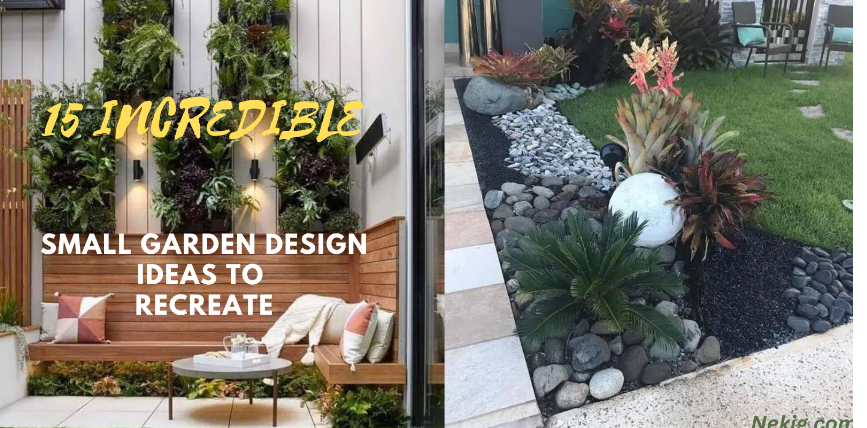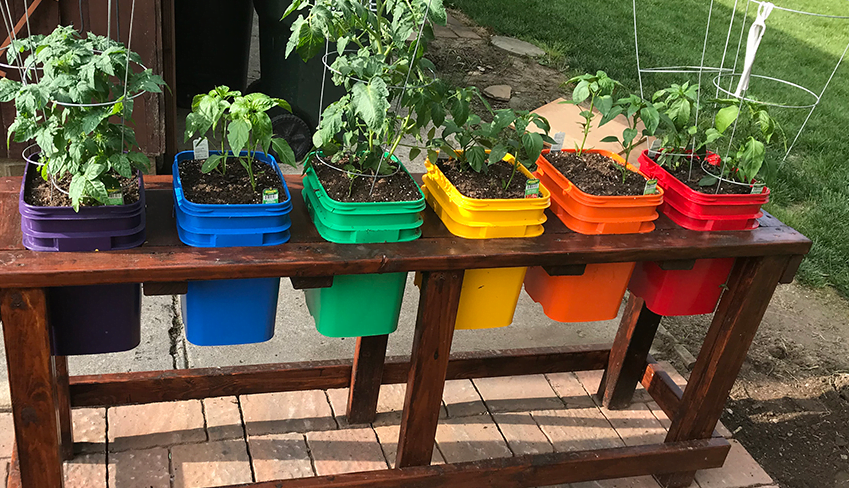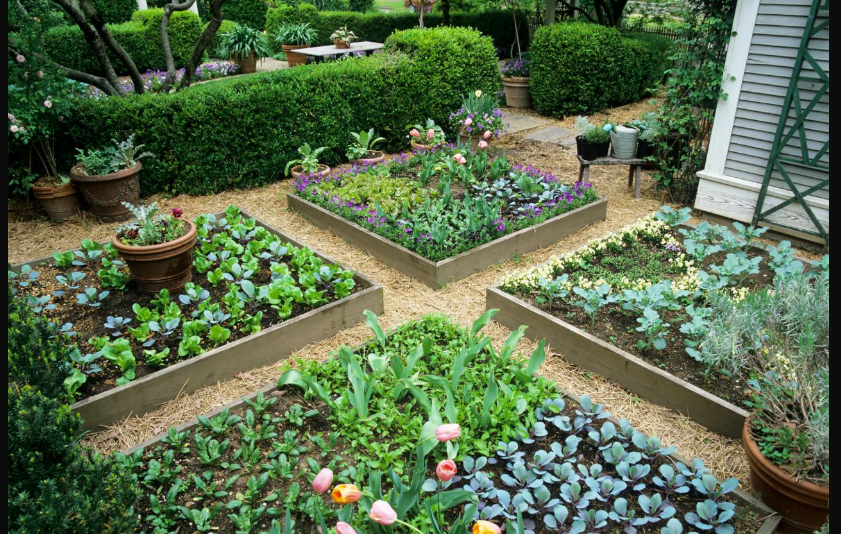
In today’s fast-paced world, having a small garden can be a true oasis of tranquility. Whether you have a tiny backyard, a balcony, or even just a small corner of your yard, you can transform it into a beautiful and functional outdoor space. In this article, we will explore 15 incredible small garden design ideas that will inspire you to recreate your own green haven.
Which Home Upgrade Does Your Space Really Need?
Answer 5 quick questions to discover the ideas that will work best for your home.
READ ALSO :
15 INCREDIBLE SMALL GARDEN DESIGN IDEAS TO RECREATE
DIY GARDENING HACKS: IDEAS TO TRANSFORM YOUR BACKYARD
10 FABULOUS GARDEN DECORATION IDEAS WITH ROCKS AND STONES
Now, let’s dive into each of these small garden design ideas step by step.
1.Vertical Garden: Maximizing Space

One of the most effective ways to make the most of limited space is by creating a vertical garden. You can utilize a wall or fence to install pocket planters or trellises and grow herbs, flowers, or small vegetables. Vertical gardens not only save space but also add a touch of greenery to otherwise unused areas.
How To Start A Vertical Garden?
Vertical cultivating addresses a creative approach to developing plants that makes it conceivable to develop climbing plants, for example, pumpkins and beans as well as non-climbing plants on walls. This cutting edge method has upset the plan of the conventional nursery, giving it a novel, three-layered and outwardly dazzling aspect.
There are a few variables to consider while arranging an upward garden.
It is critical to Pick the right area. It tends to be inside or outside, yet it should get adequate daylight.
It is critical to pick the right plants, on the grounds that few out of every odd plant can flourish in an upward garden. Hence, doing explore in advance is vital.
At long last, settling on a reasonable emotionally supportive network is vital, for which there are a few choices. It is critical to pick the one that best suits your requirements.Click the Close to see the remainder of the article
2.Container Gardening: A World in a Pot

Container gardening is a versatile option for small gardens. Use various pots, containers, and hanging baskets to create a diverse garden with different levels and textures. You can grow anything from colorful flowers to dwarf fruit trees, all while maintaining control over the soil and environment.
How Do You Create a Container Garden? Start Here.
Creating a container garden is a great way to enjoy gardening, even if you have limited space or poor soil quality. Whether you want to grow flowers, herbs, vegetables, or a combination of plants, here’s a step-by-step guide to help you get started:
Choose Your Containers:
Select containers that suit the size and needs of your plants. Almost anything can be used as a container, from traditional pots to recycled items like buckets, old tires, or wooden crates.
Ensure your containers have drainage holes at the bottom to prevent waterlogged soil. If they don’t, you can drill or puncture holes in them.
Select the Right Soil:
Use a high-quality potting mix that provides good drainage and aeration. Avoid using garden soil, as it can be too heavy and may not drain well in containers.
Pick Your Plants:
🎯 Discover Your Home Decor Style
Choose plants that are well-suited to your container’s size, location, and sunlight availability. Consider the following factors:
Sunlight: Some plants require full sun, while others thrive in partial shade or full shade.
Size: Ensure that the mature size of the plants you choose fits the container.
Watering Needs: Match plants with similar water requirements if planting in the same container.
Planting:
Fill your container with potting mix, leaving enough space at the top for watering. You can also add a layer of gravel or small stones at the bottom for additional drainage.
Gently remove the plants from their nursery pots, loosen the roots if they are tightly bound, and place them in the container. Space them according to their mature size.
Fill in the gaps with more potting mix, leaving about an inch of space at the top of the container.
Water thoroughly to settle the soil and hydrate the plants.
Watering:
Container gardens typically require more frequent watering than plants in the ground because containers dry out faster. Water when the top inch of soil feels dry to the touch, but avoid overwatering, which can lead to root rot.
Use a saucer under the container to catch excess water and prevent it from damaging surfaces.
Fertilizing:
Container plants benefit from regular fertilization since nutrients in the potting mix can deplete over time. Use a balanced, slow-release fertilizer or a liquid fertilizer according to package instructions.
Maintenance:
Monitor your container garden regularly for pests, diseases, and signs of stress. Remove dead or yellowing leaves and spent flowers.
Consider staking or providing support for tall or vining plants.
Prune as needed to maintain the shape and size of your plants.
Harvesting (if growing edibles):
If you’re growing vegetables, herbs, or fruit in your container garden, harvest when the produce is ripe to encourage continuous growth.
Seasonal Care:
Some plants may need protection from frost in the winter. Consider moving your containers to a sheltered location or insulating them as necessary.
Enjoy Your Garden:
Container gardening is a flexible and rewarding hobby. Experiment with different plants, arrangements, and container types to create a beautiful and functional garden space
3.Miniature Zen Garden: Finding Serenity
For those seeking tranquility in a small space, a miniature Zen garden can be the perfect choice. Incorporate pebbles, a small water feature, and carefully placed bonsai trees or dwarf bamboo to create a peaceful and meditative atmosphere.
Creating a miniature Zen garden is a delightful way to cultivate a sense of serenity and mindfulness in a small, peaceful space. Zen gardens, also known as Japanese rock gardens, are designed to promote relaxation and meditation. Here’s a step-by-step guide to help you create your own miniature Zen garden:
Materials You’ll Need:
Container: Select a shallow, rectangular container or tray as the base for your Zen garden. It can be made of wood, ceramic, or any material of your choice.
Sand or Gravel: White or light-colored sand or fine gravel is traditionally used in Zen gardens. You can find these materials at garden centers or craft stores.
Rocks: Choose a few large, smooth stones or pebbles to represent islands or mountains within your garden.
Rake: A small wooden or bamboo rake is used to create ripples and patterns in the sand.
Optional Decorative Elements: You can add small figurines, miniature bonsai trees, or other decorative elements if you wish.
Steps to Create Your Miniature Zen Garden:
Choose a Location: Find a quiet and peaceful spot where you can place your Zen garden. It could be indoors on a table or outdoors in a garden area.
Prepare the Container:
Place the container or tray in your chosen location.
If using an indoor container, you may want to line the bottom with a plastic sheet to prevent water damage to surfaces.
Fill with Sand or Gravel:
Pour the sand or gravel evenly into the container to create a smooth, level surface. You’ll want a layer about 1-2 inches deep.
Arrange the Rocks:
Place the larger rocks or stones strategically on the sand or gravel. These represent islands, mountains, or other natural elements. Traditional Zen gardens often have an odd number of rocks (e.g., 3 or 5) for balance.
You can experiment with different rock arrangements until you find a design that feels harmonious to you.
Create Patterns with the Rake:
Use the rake to create patterns in the sand or gravel. The act of raking is a meditative practice in itself. You can create ripples, waves, or intricate lines.
Experiment with different patterns and take your time to enjoy the process.
Optional Decorations:
If you want to add figurines or plants, place them thoughtfully within the garden. Bonsai trees, moss, or small succulents can be excellent choices.
Maintain Your Zen Garden:
Over time, the sand or gravel may become uneven or disturbed. Periodically, rake the sand to restore the patterns and ensure the rocks are properly placed.
Water any plants as needed and keep an eye out for debris.
Enjoy the Serenity: Spend some time each day or whenever you need to relax by gazing at your Zen garden. The simplicity and tranquility of the design can help clear your mind and promote a sense of peace.
[mashshare]
4.Herb Spiral: Culinary Delights in Small Spaces

An herb spiral is a clever way to grow a variety of herbs in a compact area. Construct it from stones or bricks to create multiple planting levels, allowing you to access fresh herbs for your culinary creations easily.
5.Fairy Garden: A Touch of Enchantment

Bring a touch of whimsy to your small garden with a fairy garden. Set up miniature furniture, tiny plants, and even a small fairy house to create a magical and enchanting world for both children and adults to enjoy.
6.Mirror Illusion: Expanding Horizons

To create an illusion of depth and make your small garden appear larger and more open, strategically install mirrors. This simple trick not only adds visual space but also reflects the beauty of your garden.
How to Use Mirrors in the Garden
Many of us know that a mirror is used to deliver the illusions of space into a small room. It is also employed to add interest by reflecting hanging items, such as pictures or tapestries, as well as curios on a mantel piece, side board or room shelving. For centuries landscape gardeners have used water pools, feature ponds and still, or slow moving water, to reflect the flora and fauna in a country or garden setting. It expands the viewer’s horizon.
Now days, with the growth of gardening, landscaping, and making the use of small outdoor space, mirrors have been adapted to be hung, stood, and propped in a garden, patio or outdoor setting.
As autumn sets in, and the garden dies back during the winter months, now is the best time to install a garden mirror, when the garden is dormant and you can climb around without damaging your flower beds and plantings.
[mashshare]
7.Raised Beds: Organized and Productive

Raised beds are a practical addition to any small garden. They not only optimize space but also provide better drainage and control over the soil quality. Use raised beds to grow vegetables, flowers, or herbs and add structure to your garden.
- Terrarium Garden: Green Under Glass
Terrariums are a low-maintenance garden option. Create a beautiful display inside glass containers using succulents, air plants, or moss. They add a unique and visually appealing touch to your small garden.
- Climbing Plants: Vertical Elegance
Climbing plants like ivy, clematis, or climbing roses can transform your garden. Train them to grow on walls, fences, or trellises to add greenery without sacrificing ground space. This creates a lush and elegant atmosphere.
- Vertical Herb Garden: Fresh Flavors at Your Fingertips
Hang a vertical herb garden on the side of your house or a shed for easy access to fresh herbs. It not only adds a practical element to your garden but also enhances your culinary endeavors with an array of flavors.
- Balcony Garden: High-Rise Greenery
If you have a small balcony, transform it into a lush outdoor oasis with hanging planters, railing planters, and wall-mounted shelves. This vertical approach maximizes your space and creates a refreshing escape.
- Colorful Pots: Splash of Vibrance
Choose vibrant and eye-catching pots and planters to add a pop of color and personality to your small garden. The right choice of containers can elevate the aesthetic of your space.
- Rock Garden: Desert-inspired Delight
A rock garden with various sizes of rocks, gravel, and drought-tolerant plants can be an excellent choice for low-maintenance landscaping. It provides a unique and desert-inspired look to your garden.
- Mini Pond: Tranquil Waters
Add a small pond or water feature with aquatic plants and a few fish to bring a calming and refreshing element to your garden. The sound of running water can create a soothing ambiance.
- Secret Garden Nook: Cozy Retreat
Design a hidden nook with a pergola, arbor, or trellis covered in climbing plants. This secluded space offers a cozy retreat where you can relax and enjoy the beauty of your small garden.
Conclusion
Incorporating these 15 incredible small garden design ideas into your outdoor space can transform it into a vibrant and functional oasis. Whether you have a tiny balcony or a small backyard, creativity knows no bounds when it comes to gardening. Embrace these ideas and watch your small garden flourish.
FAQs
- **How can I make the most of a small balcony garden?**
– Utilize vertical space with hanging planters and wall-mounted shelves.
- **Are there any low-maintenance small garden options?**
– Terrarium gardens and rock gardens are excellent low-maintenance choices.
- **What are the best climbing plants for a small garden?**
– Consider ivy, clematis, and climbing roses for vertical elegance.
- **How can I add a touch of enchantment to my garden?**
– Create a fairy garden with miniature furniture and tiny plants.
- **What’s the benefit of a mirror illusion in a small garden?**
– Mirrors can make your garden appear larger and more open by reflecting the surroundings.

